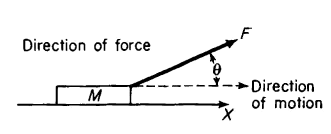| Capacitors, Magnetic Circuits, and Transformers is a free introductory textbook on the physics of capacitors, coils, and transformers. See the editorial for more information.... |

|

Home  Energy Energy  Work and Energy Work and Energy |
||||||






|
||||||
Work and Energy
Work is performed by a force when the point of application undergoes a displacement in the direction of the force. Thus in Fig. 1-1, the work dW done by the force F in displacing the body an infinitesimal distance dx in the x direction is expressed by
or in vector notation by dW = F dx In the MKS (Meter, Kilogram, Second) system of units, the unit of work is tile joule (watt-second). One joule equals the amount of work performed by a constant force of one newton when the point of application is displaced a distance of one meter in the direction of the applied force.
Generally, in the utilization of energy for the benefit of man, the stored energy present in nature is converted into mechanical, electrical, or thermal energy. The conversion usually results in all three of these forms. As an example, consider the case of a fuel such as coal, oil, or gas, when used for the generation of electric energy. First, the fuel undergoes combustion in a steam generator where its potential or chemical energy is converted into thermal energy. Part of the thermal energy is transferred to the water and steam in the steam generator. The steam enters the prime mover, usually a steam turbine, at a certain pressure and temperature and gives up part of this thermal energy. This part of the energy is converted into mechanical energy. The mechanical energy in turn is converted into electrical energy by the electric generator and into thermal energy by friction in the prime mover. In addition to the energy that is converted into other forms, there is the energy stored in the system as follows
However, regardless of the changes in the form of energy, there is no gain or loss of energy. This is in accordance with the principle of conservation of energy. If the energy were traced as it leaves the generator to the final point of utilization, it would be found that conversion and storage would continue in transformers, transmission lines, and finally in the motors or other types of devices that would convert the energy into the kind required by the user for mechanical work, heat, light, or sound.
|
||||||
Home  Energy Energy  Work and Energy Work and Energy |
||||||
Last Update: 2011-02-16


